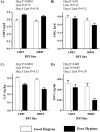Poor hygiene of housing conditions influences energy metabolism in a muscle type-dependent manner in growing pigs differing in feed efficiency
- PMID: 35568703
- PMCID: PMC9107456
- DOI: 10.1038/s41598-022-12050-6
Poor hygiene of housing conditions influences energy metabolism in a muscle type-dependent manner in growing pigs differing in feed efficiency
Abstract
The ability of pigs to cope with inflammatory challenges may by modified by selection for residual feed intake (RFI), a measure of feed efficiency. In the current study, we evaluated skeletal muscle metabolic responses to degraded hygiene conditions in pigs divergently selected for RFI. At 82 d of age, low RFI and high RFI pigs were housed in either poor or good hygiene conditions. After a 6-week challenge, the poor hygiene conditions induced a decrease in growth performance (P < 0.001) and in plasma IGF-I concentrations (P < 0.003) in both lines. In the slow-twitch oxidative semispinalis muscle, poor hygiene conditions induced a shift towards a more oxidative metabolism and an activation of the AMPK pathway in pigs of both RFI lines. In the fast-twitch glycolytic longississimus muscle, poor hygiene conditions were associated to a less glycolytic metabolism in the HRFI line only. Poor hygiene conditions also increased the protein level of lipidation of microtubule-associated protein 1 light-chain 3β (LC3-II) in both RFI lines, suggesting an activation of the autophagy pathway. Altogether, the data revealed muscle-type specific metabolic adaptations to poor hygiene conditions, which may be related to different strategies to fuel the activated immune system.
© 2022. The Author(s).
Conflict of interest statement
The authors declare no competing interests.
Figures

Similar articles
-
Hygiene of housing conditions and proinflammatory signals alter gene expressions in porcine adipose tissues and blood cells.PeerJ. 2022 Dec 13;10:e14405. doi: 10.7717/peerj.14405. eCollection 2022. PeerJ. 2022. PMID: 36530394 Free PMC article.
-
Impact of hygiene of housing conditions on performance and health of two pig genetic lines divergent for residual feed intake.Animal. 2018 Feb;12(2):350-358. doi: 10.1017/S1751731117001379. Epub 2017 Jun 27. Animal. 2018. PMID: 28651668
-
Selection for feed efficiency elicits different postprandial plasma metabolite profiles in response to poor hygiene of housing conditions in growing pigs.PLoS One. 2021 Mar 29;16(3):e0246216. doi: 10.1371/journal.pone.0246216. eCollection 2021. PLoS One. 2021. PMID: 33780478 Free PMC article.
-
Tissue-specific responses of antioxidant pathways to poor hygiene conditions in growing pigs divergently selected for feed efficiency.BMC Vet Res. 2019 Oct 16;15(1):341. doi: 10.1186/s12917-019-2107-2. BMC Vet Res. 2019. PMID: 31619228 Free PMC article.
-
Review: Feed efficiency and metabolic flexibility in livestock.Animal. 2025 Jan;19(1):101376. doi: 10.1016/j.animal.2024.101376. Epub 2024 Nov 17. Animal. 2025. PMID: 39673819 Review.
Cited by
-
Hygiene of housing conditions and proinflammatory signals alter gene expressions in porcine adipose tissues and blood cells.PeerJ. 2022 Dec 13;10:e14405. doi: 10.7717/peerj.14405. eCollection 2022. PeerJ. 2022. PMID: 36530394 Free PMC article.
References
Publication types
MeSH terms
LinkOut - more resources
Full Text Sources
Research Materials

